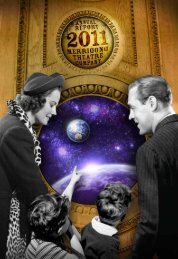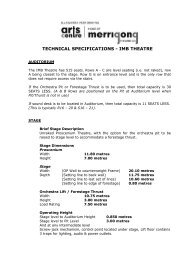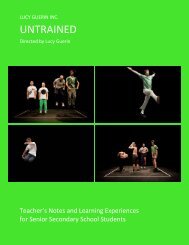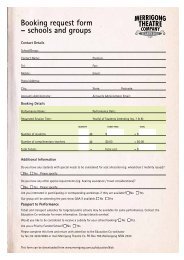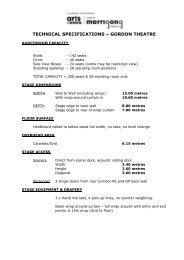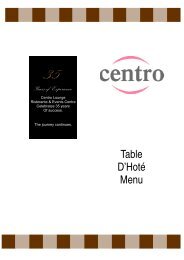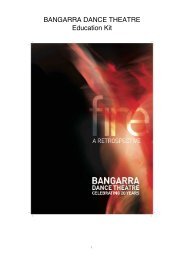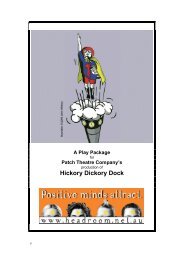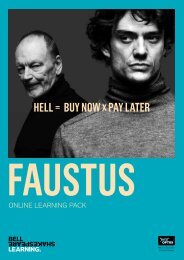Rainbow’s End
Download - Merrigong Theatre Company
Download - Merrigong Theatre Company
- No tags were found...
Create successful ePaper yourself
Turn your PDF publications into a flip-book with our unique Google optimized e-Paper software.
Transcript of Interview with Jane Harrison<br />
Riverside Theatres- July 2009<br />
Please note- this article is hyperlinked for interactive learning.<br />
Download an electronic copy from:<br />
http://www.riversideparramatta.com.au/performance.asp?pID=840<br />
Download a video of this interview from:<br />
http://www.youtube.com/watch?v=BXne7NwsCXI<br />
Q: Where did the story for <strong>Rainbow’s</strong> <strong>End</strong> come from?<br />
Rainbows <strong>End</strong> came out of commission by Ilbijerri who were the only<br />
Aboriginal and Torres straight islander theatre company in Melbourne. They<br />
asked a number of writers to write about a decade of Victorian Koori history,<br />
in particular to write about the ‘heroes’ of that era. Of course there were a lot<br />
of real life heroes that I could have written about (people like William Cooper<br />
and Pastor Doug Nicholls, people of that ilk), however, I only had eight weeks<br />
to come up with the first draft and to do a lot of that research would have<br />
taken a bit longer so I decided to write a fictional account and to write about<br />
[the time when] the men were off and away doing great work in the wider<br />
community [while] the women were often left behind keeping the family and<br />
keeping the food on the table and those kind of things. I decided the real<br />
heroes to me where the women who were keeping the families together and<br />
that everyday struggle they had, particularly living in that area around the river<br />
near Shepparton, the area called ‘The Flats’. It was about those women living<br />
on the outskirts of town and the day to day struggles they had.<br />
Q: What do you want audiences to get out of your play?<br />
In some ways, writing a historical play (because it is set around the 50’s and it<br />
does have a few real life incidences- like the Queen’s visit and the<br />
development of the housing around that area called Rumbalara- it is based on<br />
some historical facts) but it is a historical play so in a way it’s a little bit of a<br />
peep hole into that era. And it’s not so long ago, you know, it’s a little bit<br />
before my time but it’s still in living history so it’s really interesting to see how<br />
times have changed and some of the conditions that people had to live in<br />
there, living in humpies beside the river and the fact that there was no welfare<br />
and the fact that there was no support and that a lot of people had to do very<br />
menial labour because there weren’t the opportunities for education<br />
(aboriginal people were kind of locked out of a lot of those opportunities). So I<br />
think it’s fascinating that we have moved quite a long way but in some ways<br />
there are residences with some things that are happening currently- I suppose<br />
the Northern Territory interventions are another modern day equivalent of that<br />
kind of intervention with Aboriginal people’s lives. So I suppose I just want to<br />
get an insight, and also, the richness of their family life I think is important for<br />
audiences to see, because although they didn’t have the material things they<br />
had each other, they had a very supportive family life and they were very<br />
connected as a family, they’re a lovely family to me and I hope audiences<br />
respond to their warmth and the characters.<br />
4



